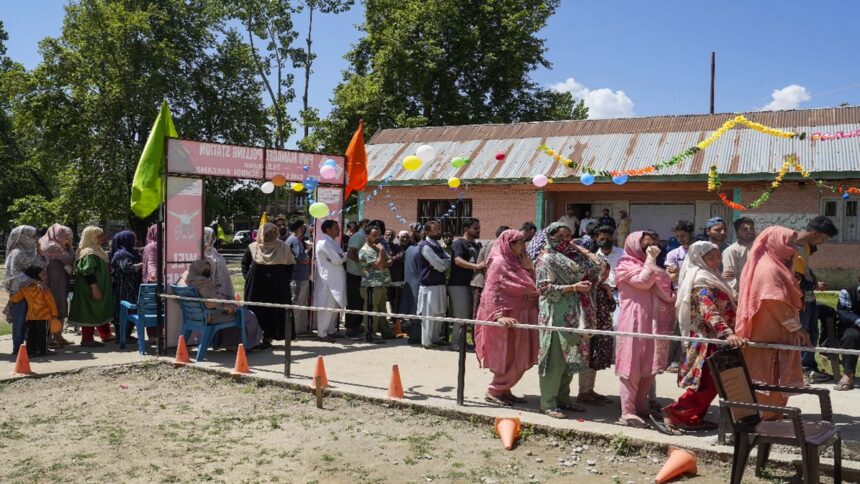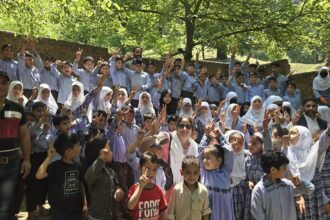Introduction
In a landmark event, the Baramulla Lok Sabha seat in Jammu and Kashmir recorded an unprecedented Voter Turnout. On May 20, it was approximately 59 percent on May 20, setting a new record in the democratic history of the constituency. This significant achievement was marked by a peaceful election process, with no reports of violence across the polling stations. The Chief Electoral Officer (CEO), Pandurang Kondbarao Pole, announced the milestone during a press conference in Srinagar. He emphasized the smooth conduct and the high level of civic engagement in Baramulla.
Background of Baramulla Lok Sabha Constituency
Baramulla is one of the six parliamentary constituencies in Jammu and Kashmir. Historically, the region has been a critical area in the political landscape of the UT due to its strategic location and diverse population. The constituency encompasses several assembly segments, including Baramulla, Sopore, Pattan, Uri, Rafiabad, Handwara, Langate, and Gurez. The socio-political dynamics of Baramulla have often reflected broader trends in the Kashmir Valley, making it a barometer for gauging public sentiment.
Historical Voting Patterns
To understand the significance of the 59 percent turnout, it is essential to examine the historical voting patterns in Baramulla. Over the past few decades, voter turnout has varied significantly, often influenced by the prevailing political and security situation. Here is a comparative analysis of past voter turnouts in Baramulla:
- 2019: 34.57%
- 2014: 39.13%
- 2009: 41.84%
- 2004: 35.65%
- 1999: 27.79%
- 1998: 41.94%
- 1996: 46.65%
The turnout in the 2024 elections marks a dramatic increase from previous years, particularly notable given the challenges the region has faced. This sharp rise indicates a renewed engagement in the democratic process among the electorate.
Factors Contributing to the High Turnout
Several factors may have contributed to the historic voter turnout in Baramulla:
- Enhanced Security Measures: The deployment of extensive security forces and monitoring through CCTV surveillance across all 2,103 polling stations likely contributed to the sense of safety among voters. The assurance of a violence-free election encouraged more people to participate.
- Voter Awareness Campaigns: Intensive voter education and awareness campaigns by the Election Commission and local civil society organizations may have played a crucial role in motivating the electorate to exercise their franchise.
- Political Mobilization: Political parties and candidates may have been more effective in mobilizing their supporters, leading to higher voter turnout. The competitive nature of the election could have spurred greater participation.
- Youth Engagement: With a significant proportion of the population being young, efforts to engage this demographic through social media and other platforms could have translated into higher voter turnout.
Polling Day Dynamics
Assembly Segment Analysis
The voter turnout varied across different assembly segments within the Baramulla constituency. Notably, the Handwara assembly segment recorded the highest turnout at 67.5 percent, whereas the Gurez assembly segment witnessed the lowest turnout. This variation highlights the differing levels of political engagement and voter enthusiasm within the constituency.
Implications of the High Turnout
The record turnout in Baramulla has several implications for the political landscape of Jammu and Kashmir:
- Strengthening of Democratic Processes: The high voter turnout reflects a strong commitment to democratic processes among the people of Baramulla, despite the region’s complex socio-political environment.
- Political Legitimacy: A higher voter turnout enhances the legitimacy of the elected representatives and the democratic process itself. It reflects a broader mandate and stronger support from the electorate.
- Influence on Future Elections: The success of the 2024 elections in terms of voter turnout and peaceful conduct could set a precedent for future elections in the region, encouraging higher participation and engagement.
The historic voter turnout in the Baramulla Lok Sabha constituency is a significant milestone in the democratic journey of Jammu and Kashmir. The achievement underscores the importance of security, voter education, and effective electoral management in fostering a vibrant democratic process. As Baramulla sets a new benchmark with its 59 percent turnout, it reflects the resilience and democratic spirit of its people, offering a hopeful narrative for the future of elections in the region.







ดูหนังโป๊ หนังเอ็ก หนังโป๊ฟรี หนังX หนังAV คลิปโป๊ XXX หี ควย | Teeneeweb.com ดูเว็บโป๊ beeg hqporner pornhub xvideos xnxx xhamster tube8 ดูหนังโป๊ และไม่ได้มีแค่นั้นเรายังมี คลิปโป๊ vk 18+ onlyfans เกย์ เลสเบี้ยน สาวสอง ทอมดี้ ที่คอยรองรับทุกท่าน ดูหนังโป๊ โป๊ของเรา หนังโป๊เด็กเย็ดสด
https://isdesr.org/can-pleasure-come-in-sorrow-lessons-for-an-genuine-christian-life-2/
https://namdolure.com/expride-b/
https://www.suntech333.com.my/what-causes-for-pale-egg-shells/
https://zeggzeggz.com/wpis-numero-uno/
https://www.worldwideautobodync.com/safety-tips-4-wheeler-driver/
https://www.trans-log.ro/2016/02/01/this-is-another-blog-post/
https://hlhgraphicdesign.com/this-post-looks-beautiful-even-with-long-interesting-title/
child porn
child teen porn
child teen
ข่มขืน หรือ รับทำเว็บ wordpress นักเรียน นักศึกษาที่เห็นหีเป็นสีชมพูสวยเราอัพเดทหนังมาใหม่ตลอดทุกวันหากใจรักในการดูหนังxฟรีคุณมาถูกทางแล้วจุดเด่น ดูหนังโป๊ ของเว็บเราก็คือดูง่ายไม่ยุ่งยากรับประกันความเร็วในการโหลดหนังแต่ละเรื่องเราขอขอบคุณทางผู้ชมที่เข้ามาเยี่ยมชมดูหนังและทำให้เราได้บรรลุในสิ่งลามกอนาจารขอบอกไว้ก่อนว่าเหมาะกับคนที่มีอายุ 18+ ขึ้นไปชื่อเว็บ หนังโป๊ไทย เราจำง่ายฝรั่งเองยังชอบ porn ในทุกๆคลิปของเราพร้อม รูปโป๊ ภาพโป๊ ดูในรูปแบบ HD ดูหนังโป๊ไทย คุณภาพสุดๆหาที่ไหนไม่ได้ต้อง รับทำ
ดูหนังออนไลน์ HD พากย์ไทย เต็มเรื่อง มาสเตอร์ ดูหนังHD 2023 ดูหนังใหม่ หนัง ดูหนังฟรี ดูหนัง เว็บดูหนังออนไลน์ หนังมาใหม่ Master zoom หนังออนไลน์ ซูม ดูหนังฟรี พากย์ไทย นำมาให้ชมกันแบบฟรี ดูหนังออนไลน์ 2024ดูหนังสนุก ดูหนังฟรี ไม่มีสะดุด ไม่มีโฆษณากวนใจ ดูหนังออนไลน์ HD พากย์ไทย เต็มเรื่อง มาสเตอร์ ดูหนังHD 2023 ดูหนังใหม่ หนัง ดูหนังฟรี ดูหนัง เว็บดูหนังออนไลน์ หนังมาใหม่ Master zoom หนังออนไลน์ ซูม ดูหนังฟรี ดูหนังออนไลน์ HD พากย์ไทย เต็มเรื่อง มาสเตอร์ ดูหนังHD 2024
ดูหนังโป๊ หนังเอ็ก หนังโป๊ฟรี หนังX หนังAV คลิปโป๊ XXX หี ควย ดูเว็บโป๊ beeg hqporner pornhub xvideos xnxx xhamster tube8 ดูหนังโป๊ และไม่ได้มีแค่นั้นเรายังมี คลิปโป๊ vk 18+ onlyfans เกย์ เลสเบี้ยน สาวสอง ทอมดี้ ที่คอยรองรับทุกท่าน ดูหนังโป๊ โป๊ของเรา หนังโป๊เด็กเย็ดสด
matadorbet porn
Keepadvancing
Supertotobet, �e�itli online bahis ve casino oyunlar� sunan g�venilir bir platformdur. Geni� spor bahisleri se�enekleri, canl� casino deneyimi ve pop�ler slot oyunlar� ile kullan�c�lar�na heyecan verici bir oyun ortam� sunar.
I was examining some of your posts on this website and I believe this web site is rattling
instructive! Continue posting.Raise blog range